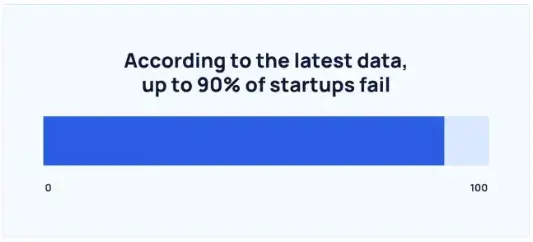In 2023, the number of online consumers stands at a massive 2.64 billion, which - to put it in perspective - makes up a third of the planet’s population.
Creating an eCommerce platform for your startup, then, is a no-brainer as it ensures you will reach a broader audience in a shorter amount of time.
But, for all its benefits, creating an online shopping experience comes with its hurdles.

We've put together some of the main pain points you should be aware of to help you get ahead of future challenges and build your eCommerce startup on solid foundations.
What are the Main Concerns When Creating an eCommerce Startup?
- Finding a Fresh Idea
- Getting Funding Approval
- Customer Conversion and Retention
- Meeting Customer Expectations
- Remaining Consistent Across Platforms
- Maintaining Data Security
Custom image created in Canva
1. Finding a Fresh Idea
The world of eCommerce is undeniably saturated, with an online shop for almost every product you can think of.
If you’re creating a startup, finding a fresh idea and unique approach for your business isn’t always easy.
But your USP is important, so take the time to find something solid that’ll help your brand stand apart from your competitors.

It could be the product if you’re offering something innovative to the market.
But you can also differentiate your eCommerce startup based on your approach to marketing, your values and ethos (a quick reminder here that over 80% of consumers are looking for sustainable businesses), or the relationships you build with your customers.
To find a fresh idea, do lots of market research. Spot unfilled gaps and determine whether there’s demand in that area. If so, you just found a new uncatered market corner!
2. Getting Funding Approval
Depending on the sort of eCommerce company you’re building and your initial capital, you’ll likely need a loan or funding in the early days of your startup.
Gaining additional money to invest in your company is a great way to boost conversions and growth and start turning a profit, building the quality brand you envision. But, being approved for apex trader funding isn’t always easy.
Before you start, ensure you have a detailed e-commerce business plan that shows why a lender or financier would want to invest in your idea.
Know how much money you need, what you intend to use the funds for, and the rate of return you expect on the investment.
It’s wise to get your finances in order, too. According to Fair Credit, one in four credit reports contain errors, for example.
Ensure that yours is accurate before applying for funding, and gather financial statements before your first meetings to prevent delays.
Lenders are more likely to approve funding when applicants are well-prepared with clear plans and financials. To manage small business loans efficiently, many rely on micro loan software to automate processes and reduce turnaround time.
3. Customer Conversion and Retention
70% of startups fail within the first five years, largely because they don’t have enough customers to turn a profit.

Source: explodingtopics.com
With millions of other eCommerce sites, it can be tough to get noticed, but it's a non-negotiable if you want to survive.
When creating your business plan, focus on customer conversion and retention. Fortunately, there are a lot of tools out there that can make securing sales easier.
At POWR, for example, our customer-focused apps help you convert three times more browsers into shoppers, using strong call-to-action campaigns to encourage visitors to convert.
Don’t underestimate the power of analytics, either. Using data collected from your websites, apps, and other digital platforms, you can monitor user behavior and base future decisions on what you learn.
4. Meeting Customer Expectations
Customers' expectations are sky-high regarding what a brand should offer them.
When it comes to customer service, for example, 90% of consumers expect a response instantly (which usually refers to 10 minutes or less) and view it as crucial to a positive experience.
As a startup, though, meeting these expectations can be tricky. We recommend starting by getting to grips with what your industry audience views as the most important.
Using feedback form templates, survey your customers on what a positive brand experience means to them, and ask them to rank certain services based on importance.
Based on their feedback, you can prioritize which expectations you should focus on first.
5. Remaining Consistent Across Platforms
Most startups follow an omnichannel strategy as consumers use multiple platforms, so your eCommerce business should provide smooth, consistent branding across touchpoints.
To maintain an omnichannel approach without becoming overwhelmed, create a clear branding strategy, communicate it to your entire team, and establish an easy review process to ensure new systems meet expectations.
Ensure design, messaging, and tone of voice consistency, and keep your various platforms up to date with product information.
6. Maintaining Data Security

As an eCommerce startup, you will handle sensitive customer data, from credit card details to home addresses. You must protect all vital information in compliance with legal regulations.
Data breaches also negatively harm your brand image, with hacking and fraud instantly making your eCommerce company less trustworthy in the eyes of consumers.
To optimize your security, switch to HTTPS protocols, implement a reputable third-party payment processing system, and obtain PCI DSS accreditation.
Market these safety measures, too, and let your audience know your eCommerce startup takes its data security seriously.
Final Words
Creating an eCommerce startup is an exciting journey that comes with its fair share of challenges!
Hopefully, the pain points identified here will help you prepare for future obstacles and create a flourishing online business designed to survive for the long term.



